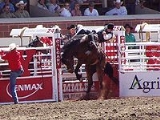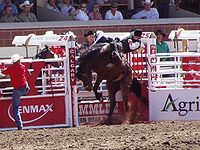
Bucking
Encyclopedia

Reasons for Bucking
Bucking, though a potentially dangerous disobedience when under saddle, is a natural aspect of horse behaviorHorse behavior
Horse behavior is best understood from the perspective that horses are prey animals with a well-developed fight-or-flight instinct. Their first response to a threat is to flee, although they are known to stand their ground and defend themselves or their offspring in cases where flight is...
. It developed in the wild for the purpose of protection from feline predators such as mountain lions, who would attack horses by dropping onto their backs from above. The process of kicking out with both hind legs, another defense mechanism for the horse, also results in a mild bucking movement. Thus, for a human to safely ride a horse, the horse has to be desensitized to the presence of something on its back and also learn not to kick out with both hind legs while under saddle. Nonetheless, because the instinct is always there, bucking can still occur for a number of reasons:
- Happiness, such as when a horse bucks during a gallop because he is enjoying himself, or during play.
- General excitement, such as horses that buck in a crowded schooling ring or at the beginning of a ride in a crowd of horses, such as an endurance rideEndurance ridingEndurance riding is an equestrian sport based on controlled long-distance races. It is one of the international competitions recognized by the FEI. There are endurance rides worldwide....
. - The rider's aidsRiding aidsRiding aids are the cues a rider gives to a horse to communicate what they want the animal to do. Riding aids are broken into the natural aids and the artificial aids.-Natural aids:...
are causing confusion or fear in the horse, and the horse responds by bucking. - The horse is "fresh," having been kept up in a stall for a long period of time, and is releasing pent-up energy.
- Pain, which may be due to an ill-fitting saddle or another piece of equipment, tooth problemsHorse teethHorses' teeth are often used to estimate the animal's age, hence the sayings "long in the tooth", "straight from the horse's mouth" and "Don't look a gift horse in the mouth".- Types of teeth :At five years of age a horse has between 36 and 44 teeth...
, or other medical issues. - Provocation, usually due to an insect bite (usually on the hindquarters) which the horse is trying to rid himself of, or in some cases a response to use of a whipWhipA whip is a tool traditionally used by humans to exert control over animals or other people, through pain compliance or fear of pain, although in some activities whips can be used without use of pain, such as an additional pressure aid in dressage...
on the flank or hindquarters. - Untrained horses may instinctually buck the first few times they have a saddle on the back if not given proper ground trainingHorse trainingHorse training refers to a variety of practices that teach horses to perform certain behaviors when asked to do so by humans. Horses are trained to be manageable by humans for everyday care as well as for equestrian activities from horse racing to therapeutic horseback riding for people with...
, and occasionally, even with proper preparation. This is an instinctive defense mechanism. - Having found that bucking the rider off results in not having to work, the horse does it to avoid his exercise.
- Disobedience to the riding aidsRiding aidsRiding aids are the cues a rider gives to a horse to communicate what they want the animal to do. Riding aids are broken into the natural aids and the artificial aids.-Natural aids:...
, when a horse does not wish to do what is asked by the rider. Sometimes this is due to poor riding on the part of the person, but sometimes a horse attempts to evade a legitimate request by bucking. - Rodeo broncs are used specifically as bucking horses, usually bred to be prone to bucking and encouraged to buck whenever a rider is on their back with the help of a "bucking strap" around their flank.
- Fear of loud and noisy machines, like cars, trucks, trains, and planes. In response to the tragic injuries that have resulted, the American courts have uniformly held that "the needs of a modern, industrial society often conflict with and generally must prevail over the delicate sensibilities of horses."
Ordinary riders need to learn to ride out and correct a simple buck or two, because it is a relatively common form of disobedience. Further, at times, movement akin to bucking is actually required of a horse: Horses that are jumping
Show jumping
Show jumping, also known as "stadium jumping," "open jumping," or "jumpers," is a member of a family of English riding equestrian events that also includes dressage, eventing, hunters, and equitation. Jumping classes commonly are seen at horse shows throughout the world, including the Olympics...
over an obstacle actually are using almost the same action as bucking when launching themselves into the air, it is simply carried out with advanced planning over a higher and wider distance. The classical dressage
Classical dressage
Classical dressage evolved from cavalry movements and training for the battlefield, and has since developed into the competitive dressage seen today...
movement known as the Capriole is also very similar to the low buck done by a horse when it kicks out with both hind legs.
Solutions to bucking
Bucking, especially if triggered by fear, pain or excitement, is generally a minor disobedience, unless it is strong enough to unseat the rider, at which point it is a dangerous act. If bucking is a premeditated act of the horse and becomes an undesired habit (such as when a horse learns to buck off a rider so that he will no longer have to work), then the horse must be re-schooled by a professional trainer. There have been OlympiansOlympic Games
The Olympic Games is a major international event featuring summer and winter sports, in which thousands of athletes participate in a variety of competitions. The Olympic Games have come to be regarded as the world’s foremost sports competition where more than 200 nations participate...
who have had to send their horses for re-training by a specialist.
It is important to address the problem of the bucking immediately. Even with good cause, it is a potentially dangerous disobedience that cannot be encouraged or allowed to continue. However, a rider does need to be sure that it is not poor riding that is causing confusion, or a result of poorly-fitting tack that is causing the horse pain. The horse's turn-out schedule should also be assessed, as extra turn-out will give a horse to release his extra energy before the rider gets on. In certain cases (such as a show, when horses are unable to be turned-out for extended periods), longeing
Longeing
Longeing or lungeing is a technique for training horses, where a horse is asked to work at the end of a long line and respond to commands from a handler on the ground who holds the line. It is also a critical component of the sport of equestrian vaulting...
the horses for a brief period can help calm him enough so that the rider can get on.
If a horse bucks, the best solution is to use one direct rein to pull the horse's head sideways and up, turning the horse in a small circle. If a rider pulls the horse's head up with both reins, the horse's neck is stronger and the rider is likely to be flipped over the horse's head. By turning the horse sideways, the rider has more leverage and a horse cannot easily buck while turning around. When the horse stops bucking, it must be asked to move forward; a horse also cannot buck very hard while moving forward. Usually a horse gives some warning that it is about to buck by dropping its head, slowing down or stopping, and excessively rounding up in the back (cowboys referred to this as "getting a lump in the back"). To discourage bucking when the rider anticipates it, the rider should ask the horse to move forward or in a circle, raise their hands and the horse's head, and deliberately put the horse into a hollowed-out frame for a moment by sitting back a bit with their heels down, seat deep, and shoulders slightly back. This will help a rider stay in balance if the horse bucks, and the act of deliberately raising the head and hollowing out the horse's back reduces the power and severity of the buck. Certain training aids, such as a gag bit
Gag bit
The gag bit is a type of bit for a horse. With two sets of reins, the gag bit gives a rider the ability to use either a standard direct action or a gag action. In this, the gag bit is related to a Pelham bit and a double bridle...
, certain types of martingale
Martingale
Martingale can refer to:*Martingale , a stochastic process in which the conditional expectation of the next value, given the current and preceding values, is the current value*Martingale for horses...
or, particularly on ponies, an overcheck
Bearing rein
A bearing rein, known today as an overcheck or a checkrein, is a piece of horse tack that runs from a point on the horse's back, over the head, to a bit. A bearing rein is used to prevent the horse from lowering its head beyond a fixed point...
, may also discourage bucking.
Consequences of chronic bucking
Horses that are chronic and consistent buckers cannot be ridden safely and if they cannot be retrained, become unsuitable for any type of ordinary riding. There are few options available to such an animal.In a few cases, a horse that cannot be trained not to buck may be sold to a rodeo
Rodeo
Rodeo is a competitive sport which arose out of the working practices of cattle herding in Spain, Mexico, and later the United States, Canada, South America and Australia. It was based on the skills required of the working vaqueros and later, cowboys, in what today is the western United States,...
stock contractor
Stock contractor
A Stock contractor is an individual or business that provides animals for rodeo competition. Stock contractors supply "rough stock" - Saddle bronc and bareback bronc horses and bull riding bulls, plus steers for steer wrestling and team roping, plus calves for calf roping events...
. Ironically, such horses often fetch a high price in the bucking stock
Bareback riding
Bareback riding is a form of horseback riding without a saddle. It requires skill, balance, and coordination, as the rider does not have any equipment to compensate for errors of balance or skill....
world because they are easy to handle on the ground, yet very clever and skilled at unseating riders, thus allowing a cowboy
Cowboy
A cowboy is an animal herder who tends cattle on ranches in North America, traditionally on horseback, and often performs a multitude of other ranch-related tasks. The historic American cowboy of the late 19th century arose from the vaquero traditions of northern Mexico and became a figure of...
to obtain a high score if he can stay on. At rodeo auctions such as the Miles City Bucking Horse Sale
Miles City Bucking Horse Sale
The Miles City Bucking Horse Sale is a major auction of rodeo stock held the third weekend every May in Miles City, Montana and the premier social event for the community...
, a spoiled riding horse, particularly one that is powerfully built, will bring a top price and enjoy a long career doing what they have learned to do.
Many other horses that cannot be trained not to buck cannot find a home anywhere and will eventually wind up being sold for horsemeat.

